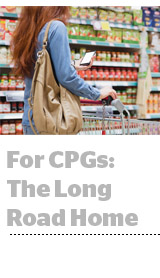 America’s most data-driven retailers and product manufacturers increasingly use mobile channels to drive shoppers to a store.
America’s most data-driven retailers and product manufacturers increasingly use mobile channels to drive shoppers to a store.
Take the big kahuna. Walmart two weeks ago began offering discounts for products selected online and then picked up at a store.
Walmart clears the margin on those discounts because the retailer can push products through its stores instead of the costlier fulfillment of ecommerce.
Brick-and-mortars haven’t had a lot of success positioning their stores as a “differentiating asset” against ecommerce, said Jerry Sheldon, VP of technology at the retail consultancy IHL Group.
But there’s clear value merging in-store and digital shopping. The lifetime value of a customer who shops in-store and online with a retailer is almost 30% higher than someone who buys in one channel, he said, even among loyal shoppers.
“What they’re incrementally discounting is peanuts if they can accrue any of that value,” Sheldon said.
And that’s Walmart’s plan. One Walmart ecommerce executive speaking on background said one goal for the store pickup program is to marry the kinds of products typically bought online – like electronics, tools and furniture – with the high-volume grocery and packaged food sales that still happen primarily in stores.
And it isn’t just Walmart.
The shopping rewards app Shopkick launched a grocery vertical last month specifically to address the concerns of CPG companies. Shopper marketing budgets, which historically go to last-leg efforts like getting products on high-performing shelves or promoting a brand in an aisle end cap, are “leaking out” of the store and into mobile channels, said company CEO Bill Demas.
One pilot customer, the Italian food manufacturer Barilla, used Shopkick as a direct extension of its shopper marketing campaign with Target, where it knew it already had in-store promotions performing well, Demas said. “The amount they spend to generate in-store visibility dwarfs what’s spent on online advertising.”
The men’s grooming company Harry’s is known for its online subscription business, providing monthly packages of razors, shaving cream and lotion, but in-store distribution deals with retailers like J.Crew and Target have “reshaped our marketing program,” said one marketing executive with the startup who agreed to speak on background.
Harry’s advertising funnel was geared to drive free tests and subscriber sign-ups, but getting people to a Target, where its products are often displayed in a branded mini-kiosk station, is so effective that in less than a year it became a primary focus for the startup’s marketing, the executive said.
Target has its own advertising platform, Guest Access, that allows brands to reach known Target shoppers online in order to promote products carried in the store.
Guest Access is an independent trading desk owned by Target, but two CPG marketers who use the service told AdExchanger brands have stopped thinking of it as mobile or programmatic budgets and have started to bundle it with shopper marketing, since it functions more like in-store signage than online brand spending.
“We have a digital attribution vendor that came back and said, ‘Hey, what’s Guest Access? They aren’t showing the same brand lift as other online campaigns,’” said a media buyer for a CPG brand carried in Target speaking on background due to a nondisclosure agreement. “But you can’t compare Guest Access to campaigns with The Trade Desk because if we can even fractionally improve our in-Target performance – not just in-store, but in-Target – that moves our business more than any online advertising.”












